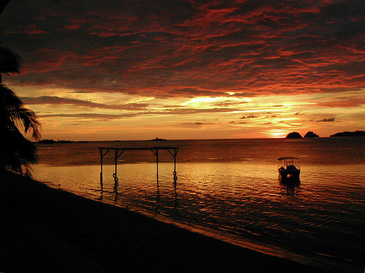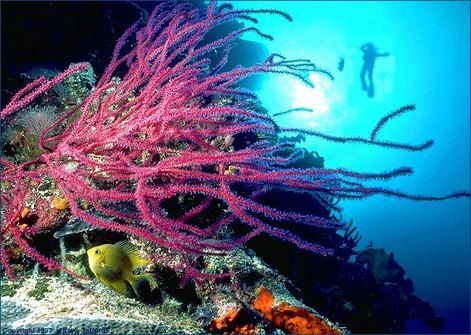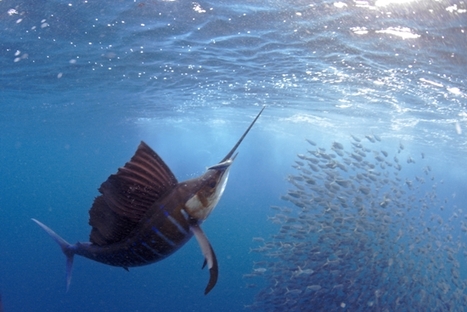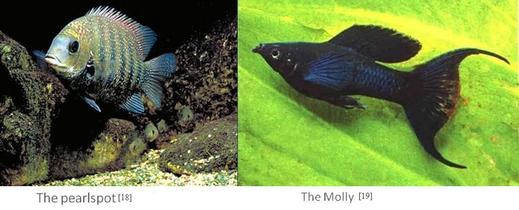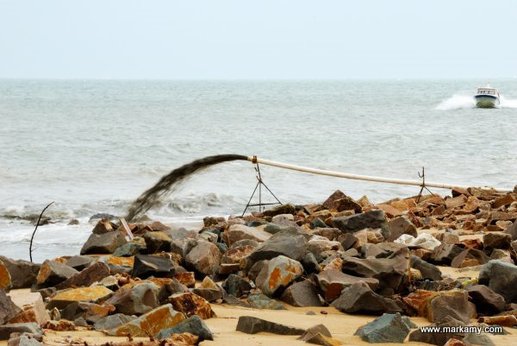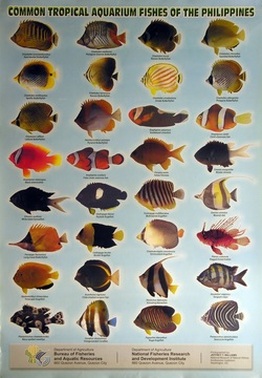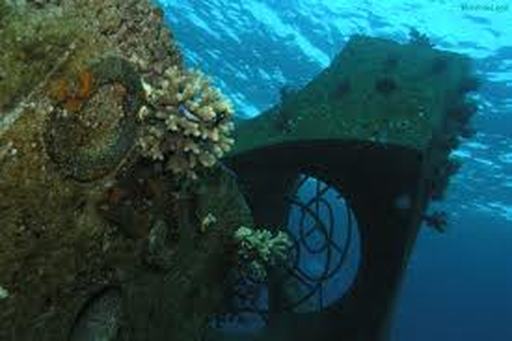The South China Sea
Introduction
The South China Sea is located slightly above the Equator, just southeast of China. The sea has been an important body of water since the Babylonians first sailed it in 425 BCE. After this it was used as an important trade route for silk. Presently, the sea supports a large commercial shrimp fishery as well as sustenance fishing for millions who live in the area. The tropical waters contain an abundance of habitats and organisms that are being affected by human use of the sea. A major problem in the South China Sea is the extraction of organisms for commercial purposes such as fisheries and aquarium trade. Artificial reefs and marine reserves may be able to lessen the damage caused by these extractions.
Table of Contents
- Introduction
- Table of Contents
- Basic Information
- Biodiversity - Habitats
- Biodiversity - Organisms
- Food Webs and Major Organisms
- Historical Use of Region
- Habitat Changes
- Major Fisheries
- How Fisheries are Managed
- Introduced Species
- Pollution
- Issues Specific to Region - Aquarium Trade
- Potential Solutions
- References - Literature
- References - Graphics
- Table of Contents
- Basic Information
- Biodiversity - Habitats
- Biodiversity - Organisms
- Food Webs and Major Organisms
- Historical Use of Region
- Habitat Changes
- Major Fisheries
- How Fisheries are Managed
- Introduced Species
- Pollution
- Issues Specific to Region - Aquarium Trade
- Potential Solutions
- References - Literature
- References - Graphics
Basic Information
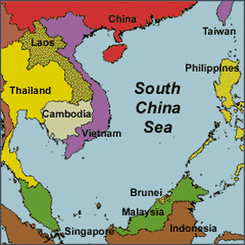
- Surrounded by 10 countries [5]
- 2,590,000 sq km [1]
- Southwestern region is shallow
(averages less than 61m) while
Northeastern contains a deep
basin (depths up to 5,490 m) [1,2]
- Contains over 3000 islands [8]
- Salinity ranges from 33-34 p.s.u. [8]
- The Asia-pacific region contains 7 of
the world's 14 largest cities and close
to 2 billion people [17]
- 2,590,000 sq km [1]
- Southwestern region is shallow
(averages less than 61m) while
Northeastern contains a deep
basin (depths up to 5,490 m) [1,2]
- Contains over 3000 islands [8]
- Salinity ranges from 33-34 p.s.u. [8]
- The Asia-pacific region contains 7 of
the world's 14 largest cities and close
to 2 billion people [17]
Biodiversity: Habitats
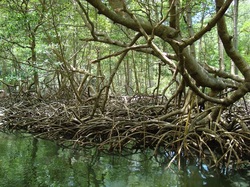
Prop roots [2]
Mangroves:
Mangrove forests are cicrumtropical ecosystems with unique terrestrial plants that have begun to invade the marine territory [9]. These terrestrial plants have unique roots that create an interesting environment for animals. The roots of these trees have two main problems that they need to overcome in order to receive oxygen from the environment. The first problem is the tide, the lower section of these trees are often inundated with the rising salt water. The second problem is the large amounts of detritus cause low levels of oxygen in the substrate, making it difficult to pull oxygen from the environment into the roots. To address these issues, the trees have evolved roots that are partially above ground [9]. An example of these roots can be seen in the picture above. These roots create nursery like habitats for many juvenile species of fish, crabs and shrimp as well as an excellent feeding ground for migratory bird species [10]. The rich plant growth causes a large amount of organic production (detritus) to be produced in the mangroves. Mangroves can produce up to 20g/m2/day of organics which is 70x more than tropical ocean waters [11]. The high productivity and nursery like conditions cause the mangroves to be an important habitat to marine, terrestrial and avian animals in this region.
Mangrove forests are cicrumtropical ecosystems with unique terrestrial plants that have begun to invade the marine territory [9]. These terrestrial plants have unique roots that create an interesting environment for animals. The roots of these trees have two main problems that they need to overcome in order to receive oxygen from the environment. The first problem is the tide, the lower section of these trees are often inundated with the rising salt water. The second problem is the large amounts of detritus cause low levels of oxygen in the substrate, making it difficult to pull oxygen from the environment into the roots. To address these issues, the trees have evolved roots that are partially above ground [9]. An example of these roots can be seen in the picture above. These roots create nursery like habitats for many juvenile species of fish, crabs and shrimp as well as an excellent feeding ground for migratory bird species [10]. The rich plant growth causes a large amount of organic production (detritus) to be produced in the mangroves. Mangroves can produce up to 20g/m2/day of organics which is 70x more than tropical ocean waters [11]. The high productivity and nursery like conditions cause the mangroves to be an important habitat to marine, terrestrial and avian animals in this region.
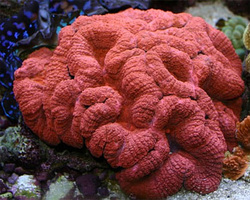
Lobophyllia brain coral [3]
Coral reefs:
Over 15% of the world's coral reefs are located in the South China Sea [3]. The tropical water temperatures and vast shallow waters support large reef ecosystems. The reef ecosystems provide habitat for other organisms by creating a complex ecosystem.
Over 15% of the world's coral reefs are located in the South China Sea [3]. The tropical water temperatures and vast shallow waters support large reef ecosystems. The reef ecosystems provide habitat for other organisms by creating a complex ecosystem.
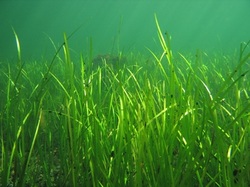
Sea grass bed [4]
Seagrass beds:
There are vast amounts of seagrass beds in the South China Sea [4, 7]. These habitats occur in shallow waters with high light penetration. These beds act as nurseries for young dimersal fish and some crustaceans [7]. The fragile nature of these beds allow for easy degradation and cause difficulty when restoration is attempted. China, along with Cambodia, Indonesia and the Philippines have recently begun to attempt restoration of these habitats [7]. These attempts have included education about the habitat, the reduction of activities that harm the beds and restoration of the beds [7].
There are vast amounts of seagrass beds in the South China Sea [4, 7]. These habitats occur in shallow waters with high light penetration. These beds act as nurseries for young dimersal fish and some crustaceans [7]. The fragile nature of these beds allow for easy degradation and cause difficulty when restoration is attempted. China, along with Cambodia, Indonesia and the Philippines have recently begun to attempt restoration of these habitats [7]. These attempts have included education about the habitat, the reduction of activities that harm the beds and restoration of the beds [7].
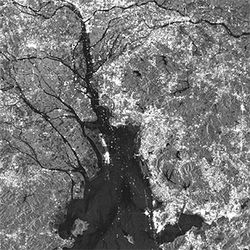
Pearl River Estuary [5]
Estuaries:
The number of estuaries in the South China Sea is debated to vary between 32 [3] and 100 [8]. The large discrepancy in these numbers may stem from a disagreement in what the authors consider a single estuary. Though the number of estuaries may be debated, it has been measured that they cover 649,000 ha [8] which converts to 6,490 km2. While these are important habitats for the organisms and people living near the South China Sea, this is a relatively small amount of habitat when compared to the 2,590,000 km2 area of the sea. The estuaries provide large amounts of primary productivity through photosynthesis as well nutrients through run-off [34]. These important habitats are heavily used by humans which have caused the degradation of them through dredging, pollution and recreational activities [34].
The number of estuaries in the South China Sea is debated to vary between 32 [3] and 100 [8]. The large discrepancy in these numbers may stem from a disagreement in what the authors consider a single estuary. Though the number of estuaries may be debated, it has been measured that they cover 649,000 ha [8] which converts to 6,490 km2. While these are important habitats for the organisms and people living near the South China Sea, this is a relatively small amount of habitat when compared to the 2,590,000 km2 area of the sea. The estuaries provide large amounts of primary productivity through photosynthesis as well nutrients through run-off [34]. These important habitats are heavily used by humans which have caused the degradation of them through dredging, pollution and recreational activities [34].
Biodiversity - Organisms
The tropical South China Sea has a very large biodiversity of organisms with:
- Over 350 species of coral [7].
- Over 2,000 species of fish [8]. Many of the fish species found in the South China
Sea are migratory [2], including species of tuna and the striped marlin
(Tetrapturus audax) [13].
- Over 530 species of phytoplankton which are primary producers [8]
- Over 850 species of algae, which are also primary producers [8]
- Some marine mammals such as the Indo-pacific humpback dolphin (Sousa
chinensis) and the finless porpoise (Neophocaena phocaenoides) [16].
- Over 350 species of coral [7].
- Over 2,000 species of fish [8]. Many of the fish species found in the South China
Sea are migratory [2], including species of tuna and the striped marlin
(Tetrapturus audax) [13].
- Over 530 species of phytoplankton which are primary producers [8]
- Over 850 species of algae, which are also primary producers [8]
- Some marine mammals such as the Indo-pacific humpback dolphin (Sousa
chinensis) and the finless porpoise (Neophocaena phocaenoides) [16].
Food Webs and Major Organisms
Food Webs
There has been very little research conducted on the food webs in the South China Sea to date. This is an oversight on the part of the fisheries managers in the region because we are extracting fish without knowing what the consequences to the food webs would be. In one research study, scientists concluded that there are three main types of predatory fish, these are: predators on largely pelagic - reside in the water column- and planktivorous fish, predators on largely bottom dwelling fish and predators that prey on a mixture of fish that live in the water column and on the ground [36]. The study concluded based on the stomach contents of the predatory fish that fish feed on different levels of the food web at different stages in their life cycle [36]. This an important find for managers because they must protect a fish's prey at all stages of it's life cycle rather than just the adult's prey. To better understand the ecosystem of the South China Sea, more work should be completed on the food webs that are apart of it.
Major Organisms [3]
The major organisms in the sea is shifting as humans exploit commercially important species, below are a few examples of organisms in each trophic level.
-High Trophic Level
- Striped marlin - Tetrapturus audax (trophic level: 4.58)
- Sword fish - Xiphias gladius (trophic level: 4.49)
- Largehead hairtail - Trichiurus lepturus (trophic level: 4.45)
- Mid Trophic Level
- Crustaceans
- Japanese Anchovy - Engraulis japonicus (trophic level: 2.51)
- Low Trophic Level
- Shrimp
There has been very little research conducted on the food webs in the South China Sea to date. This is an oversight on the part of the fisheries managers in the region because we are extracting fish without knowing what the consequences to the food webs would be. In one research study, scientists concluded that there are three main types of predatory fish, these are: predators on largely pelagic - reside in the water column- and planktivorous fish, predators on largely bottom dwelling fish and predators that prey on a mixture of fish that live in the water column and on the ground [36]. The study concluded based on the stomach contents of the predatory fish that fish feed on different levels of the food web at different stages in their life cycle [36]. This an important find for managers because they must protect a fish's prey at all stages of it's life cycle rather than just the adult's prey. To better understand the ecosystem of the South China Sea, more work should be completed on the food webs that are apart of it.
Major Organisms [3]
The major organisms in the sea is shifting as humans exploit commercially important species, below are a few examples of organisms in each trophic level.
-High Trophic Level
- Striped marlin - Tetrapturus audax (trophic level: 4.58)
- Sword fish - Xiphias gladius (trophic level: 4.49)
- Largehead hairtail - Trichiurus lepturus (trophic level: 4.45)
- Mid Trophic Level
- Crustaceans
- Japanese Anchovy - Engraulis japonicus (trophic level: 2.51)
- Low Trophic Level
- Shrimp
Historical Use of Region
The South China Sea has had a long history of use. The first recorded sailing in it was by the Babylonians in 425 BCE (Before Common Era) [5]. This sailing coincided with the shipping of Chinese silk to Greece using the sea [5]. This rich use of the sea continued through the years and in 594 CE (Common Era), a temple was built to the God of the sea. Sailors regularly prayed at the temple before voyages and artifacts including masks depicting foreigners and stone tablets detailing trades could be found at the temple [5]. The sea was historically used for shipping, such as a trade route for silk, and sustenance but commercial fishing has been on the steady rise since the 1950's [3, 5].
Habitat Changes
There have been many changes in the habitat of the South China Sea since the arrival of man. Described below are some the habitat changes and reasons behind the changes.
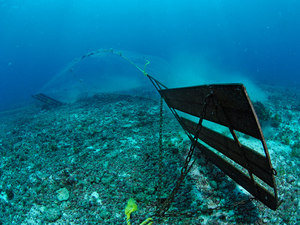
Bottom Trawling [9]
Trawling:
Trawling is a fishing technique that is widely used in the South China Sea; just under 30% of the 2006 catch was caught using either bottom trawling or mid-water trawling [3]. The large use of this fishing technique is rapidly changing the habitat of the sea floor. A study of Tolo Harbor in Hong Kong showed that one square meter of the sea floor was trawled three times a day [14]. Bottom trawling can stir up sediment, suffocating slow moving organisms or clog the feeding appendages of filter feeding animals [35]. It can also break off pieces of coral or crush fragile animals such as sea pens. The breaking occurs when the net snags on the organisms or the "doors" crush them. The door is pictured in the forefront of the photograph above; a door is positioned on either side of the net's opening and stabilizes the net and allows it to stay open. Though direct research is sparse, the large use of trawling in the South China Sea is undoubtedly changing the sea floor habitat drastically.
Trawling is a fishing technique that is widely used in the South China Sea; just under 30% of the 2006 catch was caught using either bottom trawling or mid-water trawling [3]. The large use of this fishing technique is rapidly changing the habitat of the sea floor. A study of Tolo Harbor in Hong Kong showed that one square meter of the sea floor was trawled three times a day [14]. Bottom trawling can stir up sediment, suffocating slow moving organisms or clog the feeding appendages of filter feeding animals [35]. It can also break off pieces of coral or crush fragile animals such as sea pens. The breaking occurs when the net snags on the organisms or the "doors" crush them. The door is pictured in the forefront of the photograph above; a door is positioned on either side of the net's opening and stabilizes the net and allows it to stay open. Though direct research is sparse, the large use of trawling in the South China Sea is undoubtedly changing the sea floor habitat drastically.
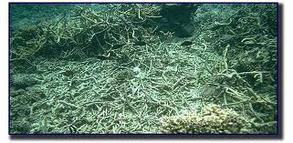
Broken coral [10]
Coral degradation:
There are two main causes of coral degradation in the South China Sea; these are dynamite fishing [2, 15] and bottom trawling [2]. Dynamite fishing is a technique that some artisan fisheries use to kill fish for easy capture. The fishermen do this by rowing a small boat up to the fishing site then tossing in a lit stick of dynamite. The explosion both kills and stuns fish, often causing them to float to the surface where the fishermen are able to easily retrieve them. Bottom trawling leads to coral degradation by snagging the net on the coral or crushing the coral with the doors of the net. The use of these fishing techniques are causing coral reefs to die and thus, changing the habitat found in the South China Sea.
There are two main causes of coral degradation in the South China Sea; these are dynamite fishing [2, 15] and bottom trawling [2]. Dynamite fishing is a technique that some artisan fisheries use to kill fish for easy capture. The fishermen do this by rowing a small boat up to the fishing site then tossing in a lit stick of dynamite. The explosion both kills and stuns fish, often causing them to float to the surface where the fishermen are able to easily retrieve them. Bottom trawling leads to coral degradation by snagging the net on the coral or crushing the coral with the doors of the net. The use of these fishing techniques are causing coral reefs to die and thus, changing the habitat found in the South China Sea.
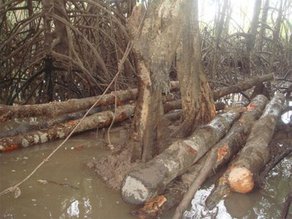
Removing mangrove trees [11]
Loss of mangroves:
As described above, mangrove forests provide an important habitat to many organisms as well as many ecosystem services. The mangrove forests along the edges of the South China Sea have been declining at an alarming rate. It is estimated that mangrove habitat is disappearing at 2% a year in Asia [10]. The mangrove forests are vanishing for multiple reasons. One reason is that the wood is being used as timber and firewood [10] while another reason is aquaculture such as shrimp and fish farming [8, 10]. In addition to habitat loss, the disappearance of mangroves causes a reduction in ecosystem services. Ecosystem services are services that the habitat provides for the ecosystem, an example for mangroves would be protection against erosion [10]. The thick, entwined nature of the roots traps sediments [9] and slows down the water movement which causes less erosion. Another ecosystem service that the mangroves provide is carbon fixation which is the process of turning atmospheric carbon into a solid, such as when plants turn CO2 into sugars [9]. Other ecosystem services that mangroves provide are the creation of oxygen through photosynthesis and the filtration of water [12]. The loss of the habitats and ecosystem services are not only detrimental to the organisms that live there but also the people who depend on the services.
As described above, mangrove forests provide an important habitat to many organisms as well as many ecosystem services. The mangrove forests along the edges of the South China Sea have been declining at an alarming rate. It is estimated that mangrove habitat is disappearing at 2% a year in Asia [10]. The mangrove forests are vanishing for multiple reasons. One reason is that the wood is being used as timber and firewood [10] while another reason is aquaculture such as shrimp and fish farming [8, 10]. In addition to habitat loss, the disappearance of mangroves causes a reduction in ecosystem services. Ecosystem services are services that the habitat provides for the ecosystem, an example for mangroves would be protection against erosion [10]. The thick, entwined nature of the roots traps sediments [9] and slows down the water movement which causes less erosion. Another ecosystem service that the mangroves provide is carbon fixation which is the process of turning atmospheric carbon into a solid, such as when plants turn CO2 into sugars [9]. Other ecosystem services that mangroves provide are the creation of oxygen through photosynthesis and the filtration of water [12]. The loss of the habitats and ecosystem services are not only detrimental to the organisms that live there but also the people who depend on the services.
Major Fisheries
A brief look at commercially important species and how they are captured.
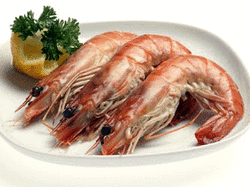
Akiami paste shrimp [12]
Species Fished:
A change in the commercially fished species has occurred over the past few decades. Up until the late 1980's Largehead hairtail (Trichiurus lepturus) created the bulk of the catch in the South China Sea fisheries. In the late 1970's crustaceans saw an increase in fishing; the crustaceans continued a relatively steady catch rate through 2006. Two other commercially important species are the Japanese Anchovy (Engraulis japonicus) and the Akiami paste shrimp (Acetes japonicus) - whose catch is considered separate from crustaceans. These two species have seen an increase in fishing in the past decade [3]. Shrimp is an important export of Thailand, with exports of 38,000 to 39,000 tonnes in 2009 [18, 19]. In 2006, over 71% of the fisheries catch was considered "mixed group" [3]. Organisms that are considered to fall under this label are invertebrates such as sea cucumbers and sea urchins, both of which are becoming popular food items in Asia.
A change in the commercially fished species has occurred over the past few decades. Up until the late 1980's Largehead hairtail (Trichiurus lepturus) created the bulk of the catch in the South China Sea fisheries. In the late 1970's crustaceans saw an increase in fishing; the crustaceans continued a relatively steady catch rate through 2006. Two other commercially important species are the Japanese Anchovy (Engraulis japonicus) and the Akiami paste shrimp (Acetes japonicus) - whose catch is considered separate from crustaceans. These two species have seen an increase in fishing in the past decade [3]. Shrimp is an important export of Thailand, with exports of 38,000 to 39,000 tonnes in 2009 [18, 19]. In 2006, over 71% of the fisheries catch was considered "mixed group" [3]. Organisms that are considered to fall under this label are invertebrates such as sea cucumbers and sea urchins, both of which are becoming popular food items in Asia.
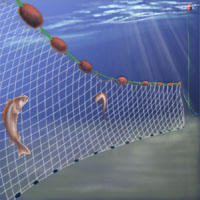
Gill net [13]
Major Fishing Methods:
There are two main methods of fishing in the South China Sea, these are trawling - both bottom and mid water - and gill nets. Combined, these two fishing methods capture 60% of the annual catch [3].
Trawling, as described in the "Habitat Changes" section, is used extensively in South China Sea's fisheries. A study conducted of Tolo Harbor in Hong Kong showed that the amount of trawling conducted in the area translated to one square meter being trawled three times a day [14]. The disruption of the habitat that occurs with each trawl is extensive. Another example of the extensive use of trawling occurs in Thailand, roughly 33% of Thailand's shrimp is caught by trawling [18].
Gill nets are used at all levels of fishing from commercial scale to personal scale [20]. Gill nets were responsible for just over 30% of the fisheries catch in 2006 [3]. Gill nets are designed to allow the fish to begin to swim through but trap the fish at the gills, preventing it's escape. Gill nets are a major threat to both sea grass beds and the dugongs that feed in the beds [21]. The nets are often anchored by weights, these weights can shift in the sediment, tearing up the seagrass. The dugongs, which are marine mammals, get tangled in the net and are put at risk of suffocation.
There are two main methods of fishing in the South China Sea, these are trawling - both bottom and mid water - and gill nets. Combined, these two fishing methods capture 60% of the annual catch [3].
Trawling, as described in the "Habitat Changes" section, is used extensively in South China Sea's fisheries. A study conducted of Tolo Harbor in Hong Kong showed that the amount of trawling conducted in the area translated to one square meter being trawled three times a day [14]. The disruption of the habitat that occurs with each trawl is extensive. Another example of the extensive use of trawling occurs in Thailand, roughly 33% of Thailand's shrimp is caught by trawling [18].
Gill nets are used at all levels of fishing from commercial scale to personal scale [20]. Gill nets were responsible for just over 30% of the fisheries catch in 2006 [3]. Gill nets are designed to allow the fish to begin to swim through but trap the fish at the gills, preventing it's escape. Gill nets are a major threat to both sea grass beds and the dugongs that feed in the beds [21]. The nets are often anchored by weights, these weights can shift in the sediment, tearing up the seagrass. The dugongs, which are marine mammals, get tangled in the net and are put at risk of suffocation.
How Fisheries are Managed
This section contains a quick over-view of fisheries management, problems with these management techniques and organisms that have been exploited due to these management practices.
Fisheries Management:
There are three different types of management practices in place in the South China Sea; these practice types are loosely based around the ecosystem, research and education and politics.
Ecosystem: The United Nations Environmental Programme and the Global Environment Facility have teamed together in an attempt to help manage the fisheries. Their stance is that if the environment of the sea is improved, populations of animals important to the fisheries will improve as well. This could be done by improving habitat critical to the organisms throughout their life cycle. The group highlights the importance of not disrupting the life cycle of an organism [7].
Research and Education:The Southeast Asian Fisheries Development Center Council (SEAFDEC) highlights the importance of researching the environment and educating locals about the fishing techniques they are using. Their stance is that the more educated the fishing population is, the less degradation of species abundance and habitat will occur [22].
Politics: It has been claimed that the largest fishery management technique effective in the South China Sea is the presence of the Exclusive Economic Zones (EEZ) [23]. An EEZ is the zone that extends from the shoreline of a country to 200 nautical miles (roughly 370km or 230mi) in which the country has the exclusive right to the resources in that zone. The perimeters of the zones are highly debated among the 10 countries surrounding the South China Sea; with each country attempting to increase their EEZ. The EEZ extends from all territorial lands which include islands; this is an important point since the South China Sea has over 3,000 islands [8].
These techniques are all highly abstract; physical management and enforcement of fishing regulations in the South China Sea are scarce. One important reason why enforcement is scarce is the lack of funding [24]. Another reason is that many countries lack any regulations in the first place [25]. Unfortunately, some of the countries with regulations in place still do not have efficient control of the situation due to corrupt policing efforts accepting bribes or avoidance of the police by fisherman [29].
Problems with these Management Techniques:
The lack of management in the fisheries has had large affects on the habitat and the populations that live in them. The fishing techniques used in the South China Sea have had serious affects on habitats such as coral reefs and sea grass beds [21]. These techniques, such as trawling, are also the cause of large amounts of by-catch. By-catch is any species that was unintentionally caught while fishing for another species. In 2004, the trawling for shrimp in Thailand caught 2.27 kg (5lbs) of by-catch for every 0.4 kg (1lb) of shrimp [18]. Though excluders - openings that allow certain by-catch organisms to escape the net - have been invented, they are not in high use around the world. These techniques and lack of regulations have allowed for many organisms to be exploited.
Exploited Organisms:
There are roughly 100 organisms that are exploited in the South China Sea [13]. Many of these species are listed by the International Union for Conservation of Nature to be vulnerable. Examples of these organisms are the Japanese Anchovy, which is an economically important fish in the region, the albacore and red sting-ray. The majority of the exploited species are from the higher trophic levels, which is influencing the food-web of the sea [3].
There are three different types of management practices in place in the South China Sea; these practice types are loosely based around the ecosystem, research and education and politics.
Ecosystem: The United Nations Environmental Programme and the Global Environment Facility have teamed together in an attempt to help manage the fisheries. Their stance is that if the environment of the sea is improved, populations of animals important to the fisheries will improve as well. This could be done by improving habitat critical to the organisms throughout their life cycle. The group highlights the importance of not disrupting the life cycle of an organism [7].
Research and Education:The Southeast Asian Fisheries Development Center Council (SEAFDEC) highlights the importance of researching the environment and educating locals about the fishing techniques they are using. Their stance is that the more educated the fishing population is, the less degradation of species abundance and habitat will occur [22].
Politics: It has been claimed that the largest fishery management technique effective in the South China Sea is the presence of the Exclusive Economic Zones (EEZ) [23]. An EEZ is the zone that extends from the shoreline of a country to 200 nautical miles (roughly 370km or 230mi) in which the country has the exclusive right to the resources in that zone. The perimeters of the zones are highly debated among the 10 countries surrounding the South China Sea; with each country attempting to increase their EEZ. The EEZ extends from all territorial lands which include islands; this is an important point since the South China Sea has over 3,000 islands [8].
These techniques are all highly abstract; physical management and enforcement of fishing regulations in the South China Sea are scarce. One important reason why enforcement is scarce is the lack of funding [24]. Another reason is that many countries lack any regulations in the first place [25]. Unfortunately, some of the countries with regulations in place still do not have efficient control of the situation due to corrupt policing efforts accepting bribes or avoidance of the police by fisherman [29].
Problems with these Management Techniques:
The lack of management in the fisheries has had large affects on the habitat and the populations that live in them. The fishing techniques used in the South China Sea have had serious affects on habitats such as coral reefs and sea grass beds [21]. These techniques, such as trawling, are also the cause of large amounts of by-catch. By-catch is any species that was unintentionally caught while fishing for another species. In 2004, the trawling for shrimp in Thailand caught 2.27 kg (5lbs) of by-catch for every 0.4 kg (1lb) of shrimp [18]. Though excluders - openings that allow certain by-catch organisms to escape the net - have been invented, they are not in high use around the world. These techniques and lack of regulations have allowed for many organisms to be exploited.
Exploited Organisms:
There are roughly 100 organisms that are exploited in the South China Sea [13]. Many of these species are listed by the International Union for Conservation of Nature to be vulnerable. Examples of these organisms are the Japanese Anchovy, which is an economically important fish in the region, the albacore and red sting-ray. The majority of the exploited species are from the higher trophic levels, which is influencing the food-web of the sea [3].
Introduced Species
Very little research of introduced species has occurred in the South China Sea, though it is safe to say that there have been introductions over the long history of it's use. There are two known fish species that have been introduced, these are: the Pearlspot (Etroplus suratensis) and the Molly (Poecilia sphenops) [13]. There are 72 species of fish that are cryptogenic [13]; this means that the species has been present for so long that it is not known whether it is native or if it was introduced before records of species were kept.
Pollution
The geography of the South China Sea has a large impact on the amount of pollution in the water. Many of the nations surrounding the sea have low levels of industrialization which leads to an overall low level of pollution [8]. At the same time, however, other nations are quickly becoming industrialized but are lacking regulations controlling the discharge of pollution into the sea, an example of this is the large amount of pesticides and fertilizers that are entering the sea as run off from Vietnam's rice farming [8]. This lack of regulations causes pockets of highly polluted waters in the sea. In order to keep the sea from becoming heavily polluted as other nations begin to industrialize, countries must be proactive and develop regulations controlling the dumping of waste into the sea. As with other seas, the wastes include not only chemicals but fishing gear and plastics as well.
Issues Specific to Region - Aquarium Trade
Introduction to Aquarium Trade:
The global aquarium trade has increased 14% annually since 1985 [26]. This trade is supplied mostly by wild caught species from the tropics; 98% of the organisms are wild caught while the remaining 2% are cultured for the aquarium trade [26]. The trade includes not only fish but also crustaceans such as crabs and shrimp, both hard and soft corals and echinoderms such as sea cucumbers and sea urchins [26, 27, 28]. The high dependence on wild caught animals have shaped the collection methods for gathering these animals.
Collection Methods:
The collection methods differ depending on the species, however, most involve the use of dive gear [28]. Since many of the organisms are captured on coral reefs in relatively shallow waters, the dive gear can include hookah, in which a hose runs from the air supply on the surface to the diver underwater, and snorkel gear [28]. The most widely used collection method for fish is spraying cyanide. The cyanide is sprayed into the water near coral, causing the fish to be stunned and thus easily caught [2, 24, 25, 28, 29]. Cyanide binds with hemoglobin in the blood stream and affects fish in a similar manner to CO poisoning in humans. In order to prevent the death of the fish, the fish must be quickly transferred to fresh saltwater and allowed to recover. Informal surveys show that the use of cyanide is decreasing as education increases on the ill effects caused by cyanide on the environment and organisms [24]. Increasing numbers of fisherman are using small nets to capture fish and crustaceans [24]. This technique is less damaging to the coral habitat and causes less biological stress on the organisms. An increase in environmental awareness has increased in the coral collection as well. A trend called clipping has begun to take hold. In this practice, a small piece of coral is clipped from the main body and transplanted onto a rock to continue growth until it is a marketable size [28]. These clipped pieces can be used for the aquarium trade as well as coral seeding after a coral habitat has been destroyed [28]. The slow evolution in manageable collection practices will hopefully continue.
Species Collected:
The main classification for species in the aquarium trade are: coral, fish and invertebrates. Thought it is difficult to attain exact numbers, there are roughly 1,500 species of fish that are traded for aquarium use [28]. However, this number includes freshwater and brackish water species as well. Some examples of marine fish from the South China Sea are the Epinephelus lanceolatus, a seahorse (Hippocampus comes) , and the tomato clown fish (Amphiprion frenatus) [13, 28, 30]. Both the E. lancelatus and the seahorse are considered have populations that are vulnerable [31]. The seahorse and the clown fish are used as decorative pieces in the aquariums while the E. lancelatus is used as a tank water quality indicator and as a good luck token [13, 30, 31]. Along with fish, coral is used as decorative pieces and as homes for animals in the aquarium. There are roughly 100 species of coral, both hard and soft, that are collected and traded for aquarium use [28]. The hard coral is mostly comprised of species from seven main genera [26]. The heavy preference for certain genera over others is most likely changing the natural distribution of corals in the South China Sea. Invertebrates are collected for aquariums for their decorative purposes as well as their practical uses. Many of the invertebrates are crustaceans that provide services such as cleaning fish or eating nuisance organisms that can degrade the quality of the tank [27]. There are almost 300 species of invertebrates that are traded for aquarium use, other animals that fall under this category are snails and sea slugs [28]. Here are some visual examples of the species that I have mentioned above:
The global aquarium trade has increased 14% annually since 1985 [26]. This trade is supplied mostly by wild caught species from the tropics; 98% of the organisms are wild caught while the remaining 2% are cultured for the aquarium trade [26]. The trade includes not only fish but also crustaceans such as crabs and shrimp, both hard and soft corals and echinoderms such as sea cucumbers and sea urchins [26, 27, 28]. The high dependence on wild caught animals have shaped the collection methods for gathering these animals.
Collection Methods:
The collection methods differ depending on the species, however, most involve the use of dive gear [28]. Since many of the organisms are captured on coral reefs in relatively shallow waters, the dive gear can include hookah, in which a hose runs from the air supply on the surface to the diver underwater, and snorkel gear [28]. The most widely used collection method for fish is spraying cyanide. The cyanide is sprayed into the water near coral, causing the fish to be stunned and thus easily caught [2, 24, 25, 28, 29]. Cyanide binds with hemoglobin in the blood stream and affects fish in a similar manner to CO poisoning in humans. In order to prevent the death of the fish, the fish must be quickly transferred to fresh saltwater and allowed to recover. Informal surveys show that the use of cyanide is decreasing as education increases on the ill effects caused by cyanide on the environment and organisms [24]. Increasing numbers of fisherman are using small nets to capture fish and crustaceans [24]. This technique is less damaging to the coral habitat and causes less biological stress on the organisms. An increase in environmental awareness has increased in the coral collection as well. A trend called clipping has begun to take hold. In this practice, a small piece of coral is clipped from the main body and transplanted onto a rock to continue growth until it is a marketable size [28]. These clipped pieces can be used for the aquarium trade as well as coral seeding after a coral habitat has been destroyed [28]. The slow evolution in manageable collection practices will hopefully continue.
Species Collected:
The main classification for species in the aquarium trade are: coral, fish and invertebrates. Thought it is difficult to attain exact numbers, there are roughly 1,500 species of fish that are traded for aquarium use [28]. However, this number includes freshwater and brackish water species as well. Some examples of marine fish from the South China Sea are the Epinephelus lanceolatus, a seahorse (Hippocampus comes) , and the tomato clown fish (Amphiprion frenatus) [13, 28, 30]. Both the E. lancelatus and the seahorse are considered have populations that are vulnerable [31]. The seahorse and the clown fish are used as decorative pieces in the aquariums while the E. lancelatus is used as a tank water quality indicator and as a good luck token [13, 30, 31]. Along with fish, coral is used as decorative pieces and as homes for animals in the aquarium. There are roughly 100 species of coral, both hard and soft, that are collected and traded for aquarium use [28]. The hard coral is mostly comprised of species from seven main genera [26]. The heavy preference for certain genera over others is most likely changing the natural distribution of corals in the South China Sea. Invertebrates are collected for aquariums for their decorative purposes as well as their practical uses. Many of the invertebrates are crustaceans that provide services such as cleaning fish or eating nuisance organisms that can degrade the quality of the tank [27]. There are almost 300 species of invertebrates that are traded for aquarium use, other animals that fall under this category are snails and sea slugs [28]. Here are some visual examples of the species that I have mentioned above:
Buyers and Suppliers:
Roughly 80% of the aquarium trade involves exports from the Philippines and Indonesia to the United States [24]. The main suppliers of the trade are Indonesia and the Philippines, which account for 66-85% of the organisms; the rest of the trade is supplied by countries surrounding the Red Sea, countries along eastern Africa, Hawaii and Florida [24]. These locations all have warm waters with tropical species of organisms that are brightly colored that are able to supply the high demand for decorative pieces. The main buyers for the aquarium trade are North America, Europe and Southeast Asia [24, 26, 28, 29]. With an estimated 700,000 aquariums in the United States [32], control over the aquarium trade is an increasingly important topic that both buyers and suppliers can participate in.
Roughly 80% of the aquarium trade involves exports from the Philippines and Indonesia to the United States [24]. The main suppliers of the trade are Indonesia and the Philippines, which account for 66-85% of the organisms; the rest of the trade is supplied by countries surrounding the Red Sea, countries along eastern Africa, Hawaii and Florida [24]. These locations all have warm waters with tropical species of organisms that are brightly colored that are able to supply the high demand for decorative pieces. The main buyers for the aquarium trade are North America, Europe and Southeast Asia [24, 26, 28, 29]. With an estimated 700,000 aquariums in the United States [32], control over the aquarium trade is an increasingly important topic that both buyers and suppliers can participate in.
Potential Solutions
There are many serious problems occurring in the South China Sea ranging from pollution to habitat loss, however, the most significant problem is fish extraction for fisheries and the aquarium trade. This is a large problem because of the havoc it reeks on the food web interactions and the effects on habitat. An example of this is the removal of herbivorous fish from a coral reef. When the fish are gone, algae is able to grow unabated and over take the coral, essentially severing access to nutrients in the water [28]. While there are many possible solutions to the extraction problem, one solution seems more plausible than others. This solution would be a combination of artificial reefs and marine reserves. Studies have shown that an area of 10-20% of a marine protected area covered by artificial coral reefs could have significant benefits for the area in terms of fish abundance. The benefits would be seen relatively quickly, in 10 years. These studies occurred in Hong Kong and predict that the benefits would still be seen even if the amount of fishing and extraction in the area continued to increase [14]. While the area directly above and around the artificial reefs would be considered "no take" in which extraction would be illegal, the concept of "spill-over" would come into affect. Spill-over is the idea that once a ecosystem on the reef began to grow, fish populations would begin to grow and eventually, some fish would migrate out of the reef and out of the "no take" zone. The fishermen in the area would then be able to extract these fish without harming the delicate balance of the reef ecosystem. While the solution is logical, it must also be plausible. A large factor in this solution is the cost of creating artificial reefs. Sinking vessels and other large structures such as cement balls allow the natural growth of organisms. Vessels are the most cost effective, even with the amount of cleaning that must be done in order to remove hazardous chemicals and pollutants [14]. Other successful structures have been simple cement structures that have been seeded with coral pieces in order to promote growth [33]. Artificial reefs are effective because of the rapid colonization of fish after the introduction of the reef to the environment, the reef provides a complex habitat [33]. While the artificial reefs have shown to be affective in increasing organism populations, they must be regulated in order to deliver a solution to the fish extraction in the South China Sea. Previous attempts of regulation have failed for reasons such as inadequate funding and corrupt policing forces [25, 29]. If the marine reserve surrounding the artificial reefs could be adequately patrolled, there is a good chance that this solution could decrease the ill affects of fish extraction in the South China Sea. It is important to note that these will not solve the problem of fish extraction, other methods would need to be applied in conjunction with the artificial reefs and marine reserves in order to solve the problem.
References - Literature
[1] "South China Sea." The Columbia Encyclopedia, Sixth Edition. 2008.
Encyclopedia.com. 7 Dec. 2010 <http://www.encyclopedia.com>.
[2] Rosenberg, David. "Managing the Resources of the China Seas: China's Bilateral
Fisheries Agreements with Japan, South Korea, and Vietnam." JapanFocus.
Web. 08 Dec. 2010. <http://www.japanfocus.org/>.
[3] "LME: South China Sea." Sea Around Us Project. Web. 08 Dec. 2010.
<http://www.seaaroundus.org/lme/36.aspx>.
[4] "Seagrass Meadows." Encyclopedia of Earth. 24 Jan. 2010. Web. 08 Dec. 2010.
<http://www.eoearth.org/article/Seagrass_meadows>.
[5] Rosenberg, David. WWW South China Sea Virtual Library. Web. 08 Dec. 2010.
<http://www.southchinasea.org/>.
[6] "Background." U.S. Energy Information Administration - EIA - Independent Statistics
and Analysis. Web. 08 Dec. 2010.
<http://www.eia.doe.gov/cabs/South_China_Sea/Background.html>.
[7] "Project Background." The UNEP/GEF South China Sea Project. UNEP/GEF, 2010.
Web. 7 Dec. 2010. <http://www.unepscs.org/Project_Background.html>.
[8] Sheppard, Charles. Seas at the Millennium: an Environmental Evaluation.
Amsterdam: Pergamon, 2000. Print.
[9] Emlet, Richard. "Mangroves." Estuarine Biology. Oregon Institute of Marine Biology,
Charleston, Oregon. 28 Oct. 2010. Lecture.
[10] Tang, Prof. DanLing and Dr. B. Satyanarayana. "Mangroves: The Imperative
Resource of Shenzhen Bay." Laboratory for Tropical Marine Environmental
Dynamics.
[11] Kathiresan. “Uses of Mangroves.” Proceeding of the Workshop on Conservation
and Management of Mangrove Ecosystems. Royal Netherlands
Embassy, Colombo. (1997): pp. 13.
[12] Kareiva, Peter and Heather Tallis. "Ecosystem Services." The Nature Conservancy.
[13] "Search FishBase." Web. 08 Dec. 2010. <http://www.fishbase.org/>.
[14] Pitcher, Tony J. et al. "Marine Reserves and the Restoration of Fisheries and
Marine Ecosystems in the South China Sea." Bulletin of Marine Science
66.3 (2000): 543-66.
[15] Khemakorn, Pakjuta. "Sustainable Management of Pelagic Fisheries in the South China Sea Region." United Nations. New York. 2006
[16] Hung, Samuel and Thomas Jefferson. "An Updated, Annotated Checklist of the
Marine Mammals of Hong Kong." Mammalia (2007): 105-114.
[17] Næss, Tom. "Environment and Security in the South China Sea Region." 1999.
[18] Cowan, Steve and Barry Schienber. Farming the Seas. Habitat Media, 2004.
[19] "Thai Shrimp Exporters Expect a Good Year." Aquaculture, Fish Farming
Information - Portal for Aquaculture and Fish Farming : TheFishSite.com. 24
Sept. 2009. Web. 08 Dec. 2010. <http://www.thefishsite.com/fishnews/10852
/thai-shrimp-exporters-expect-a-good-year>.
[20] Boonchuwongse, Pongpat and Waraporn Dechboon. "Socioeconomic Assessment
of Marine Fisheries in Thailand." The Worldfish Center. 2003.
[21] "Viet Nam Seagrass." Seagrass-Watch | Global Seagrass Assessment and
Monitoring. Web. 08 Dec. 2010. <http://www.seagrasswatch.org
/Vietnam.html>.
[22] "Welcome to SEAFDEC." Www.seafdec.org. Web. 08 Dec. 2010.
<http://www.seafdec.org/cms/index.php>.
[23] Ablan, and Garces. "A Sea Change: The Exclusive Economic Zone and Governance
Institutions for Living Marine Resources." Springer - International Publisher
Science, Technology, Medicine. 2005. Web. 08 Dec. 2010. <http://www.spri
nger.com/economics/environmental/book/978-1-4020-3132-8>.
[24] Shuman, Craig; Gregor Hodgson; Richard Ambrose. "Managing the Marine
Aquarium Trade: Is Eco-certification the Answer?" Environmental
Conservation 31.4 (2004): 339-348.
[25] Wood, Elizabeth. “Collection of Coral Reef Fish for Aquaria: Global Trade,
Conservation Issues and Management Strategies” Marine Conservation
Society. 2001.
[26] Sugiyama. "Status and Potential of Fisheries and Aquaculture in Asia and the
Pacific." FAO. 2004.
[27] Calado et al. “Marine Ornamental Decapods – Popular, Pricey, and Poorly Studied”
Journal of Crustacean Biology 23.4 (2003): 963–973,
[28] Chapman and Livengood. "The Ornamental Fish Trade: An Introduction with
Perspectives for Responsible Aquarium Fish Ownership." University of Florida
IFAS Extension. 2005.
[29] Blackmore, Dr. Graham. "Living Seas - GUE Training and Scuba Diving in
Singapore." Living Seas - GUE Training and Scuba Diving in Singapore.
2002. Web. 08 Dec. 2010.
<http://www.livingseas.com.sg/articles/article_fisheries.htm>.
[30] Food and Agriculture Organization. FAO Home. Web. 08 Dec. 2010.
<http://www.fao.org/>.
[31] Red List. IUCN - Home. Web. 08 Dec. 2010. <http://www.iucn.org/>.
[32] Fountain, Henery. "Are Aquariums Getting Too Lifelike?" The New York Times. 22
Mar. 2010. Web. 7 Dec. 2010.
<http://www.nytimes.com/2010/03/23/science/23aquarium.html?_r=1>.
[33] Bohnsack, James A., and David L. Sutherland. "Artificial Reef Research: A Review
with Recommendations for Future Priorities." Bulletin of Marine Science 37.1
(1985): 11-39.
[34] Emlet, Richard. "Estuaries." Estuarine Biology. Oregon Institute of Marine Biology,
Charleston, Oregon. 30 Sept. 2010. Lecture.
[35] Emlet, Richard. "Soft Sediment Communities." Estuarine Biology. Oregon Institute of
Marine Biology, Charleston, Oregon. 11 Nov. 2010. Lecture.
[36] Bachok, Z.; M.I. Mansor and R.M. Noordin. "Diet Composition and Food Habits of
Dimersal and Pelagic Marine Fishes from Terengganu Waters, East Coast of
Peninsular Malaysia." NAGA World Fish Center Q. 2004.
Encyclopedia.com. 7 Dec. 2010 <http://www.encyclopedia.com>.
[2] Rosenberg, David. "Managing the Resources of the China Seas: China's Bilateral
Fisheries Agreements with Japan, South Korea, and Vietnam." JapanFocus.
Web. 08 Dec. 2010. <http://www.japanfocus.org/>.
[3] "LME: South China Sea." Sea Around Us Project. Web. 08 Dec. 2010.
<http://www.seaaroundus.org/lme/36.aspx>.
[4] "Seagrass Meadows." Encyclopedia of Earth. 24 Jan. 2010. Web. 08 Dec. 2010.
<http://www.eoearth.org/article/Seagrass_meadows>.
[5] Rosenberg, David. WWW South China Sea Virtual Library. Web. 08 Dec. 2010.
<http://www.southchinasea.org/>.
[6] "Background." U.S. Energy Information Administration - EIA - Independent Statistics
and Analysis. Web. 08 Dec. 2010.
<http://www.eia.doe.gov/cabs/South_China_Sea/Background.html>.
[7] "Project Background." The UNEP/GEF South China Sea Project. UNEP/GEF, 2010.
Web. 7 Dec. 2010. <http://www.unepscs.org/Project_Background.html>.
[8] Sheppard, Charles. Seas at the Millennium: an Environmental Evaluation.
Amsterdam: Pergamon, 2000. Print.
[9] Emlet, Richard. "Mangroves." Estuarine Biology. Oregon Institute of Marine Biology,
Charleston, Oregon. 28 Oct. 2010. Lecture.
[10] Tang, Prof. DanLing and Dr. B. Satyanarayana. "Mangroves: The Imperative
Resource of Shenzhen Bay." Laboratory for Tropical Marine Environmental
Dynamics.
[11] Kathiresan. “Uses of Mangroves.” Proceeding of the Workshop on Conservation
and Management of Mangrove Ecosystems. Royal Netherlands
Embassy, Colombo. (1997): pp. 13.
[12] Kareiva, Peter and Heather Tallis. "Ecosystem Services." The Nature Conservancy.
[13] "Search FishBase." Web. 08 Dec. 2010. <http://www.fishbase.org/>.
[14] Pitcher, Tony J. et al. "Marine Reserves and the Restoration of Fisheries and
Marine Ecosystems in the South China Sea." Bulletin of Marine Science
66.3 (2000): 543-66.
[15] Khemakorn, Pakjuta. "Sustainable Management of Pelagic Fisheries in the South China Sea Region." United Nations. New York. 2006
[16] Hung, Samuel and Thomas Jefferson. "An Updated, Annotated Checklist of the
Marine Mammals of Hong Kong." Mammalia (2007): 105-114.
[17] Næss, Tom. "Environment and Security in the South China Sea Region." 1999.
[18] Cowan, Steve and Barry Schienber. Farming the Seas. Habitat Media, 2004.
[19] "Thai Shrimp Exporters Expect a Good Year." Aquaculture, Fish Farming
Information - Portal for Aquaculture and Fish Farming : TheFishSite.com. 24
Sept. 2009. Web. 08 Dec. 2010. <http://www.thefishsite.com/fishnews/10852
/thai-shrimp-exporters-expect-a-good-year>.
[20] Boonchuwongse, Pongpat and Waraporn Dechboon. "Socioeconomic Assessment
of Marine Fisheries in Thailand." The Worldfish Center. 2003.
[21] "Viet Nam Seagrass." Seagrass-Watch | Global Seagrass Assessment and
Monitoring. Web. 08 Dec. 2010. <http://www.seagrasswatch.org
/Vietnam.html>.
[22] "Welcome to SEAFDEC." Www.seafdec.org. Web. 08 Dec. 2010.
<http://www.seafdec.org/cms/index.php>.
[23] Ablan, and Garces. "A Sea Change: The Exclusive Economic Zone and Governance
Institutions for Living Marine Resources." Springer - International Publisher
Science, Technology, Medicine. 2005. Web. 08 Dec. 2010. <http://www.spri
nger.com/economics/environmental/book/978-1-4020-3132-8>.
[24] Shuman, Craig; Gregor Hodgson; Richard Ambrose. "Managing the Marine
Aquarium Trade: Is Eco-certification the Answer?" Environmental
Conservation 31.4 (2004): 339-348.
[25] Wood, Elizabeth. “Collection of Coral Reef Fish for Aquaria: Global Trade,
Conservation Issues and Management Strategies” Marine Conservation
Society. 2001.
[26] Sugiyama. "Status and Potential of Fisheries and Aquaculture in Asia and the
Pacific." FAO. 2004.
[27] Calado et al. “Marine Ornamental Decapods – Popular, Pricey, and Poorly Studied”
Journal of Crustacean Biology 23.4 (2003): 963–973,
[28] Chapman and Livengood. "The Ornamental Fish Trade: An Introduction with
Perspectives for Responsible Aquarium Fish Ownership." University of Florida
IFAS Extension. 2005.
[29] Blackmore, Dr. Graham. "Living Seas - GUE Training and Scuba Diving in
Singapore." Living Seas - GUE Training and Scuba Diving in Singapore.
2002. Web. 08 Dec. 2010.
<http://www.livingseas.com.sg/articles/article_fisheries.htm>.
[30] Food and Agriculture Organization. FAO Home. Web. 08 Dec. 2010.
<http://www.fao.org/>.
[31] Red List. IUCN - Home. Web. 08 Dec. 2010. <http://www.iucn.org/>.
[32] Fountain, Henery. "Are Aquariums Getting Too Lifelike?" The New York Times. 22
Mar. 2010. Web. 7 Dec. 2010.
<http://www.nytimes.com/2010/03/23/science/23aquarium.html?_r=1>.
[33] Bohnsack, James A., and David L. Sutherland. "Artificial Reef Research: A Review
with Recommendations for Future Priorities." Bulletin of Marine Science 37.1
(1985): 11-39.
[34] Emlet, Richard. "Estuaries." Estuarine Biology. Oregon Institute of Marine Biology,
Charleston, Oregon. 30 Sept. 2010. Lecture.
[35] Emlet, Richard. "Soft Sediment Communities." Estuarine Biology. Oregon Institute of
Marine Biology, Charleston, Oregon. 11 Nov. 2010. Lecture.
[36] Bachok, Z.; M.I. Mansor and R.M. Noordin. "Diet Composition and Food Habits of
Dimersal and Pelagic Marine Fishes from Terengganu Waters, East Coast of
Peninsular Malaysia." NAGA World Fish Center Q. 2004.
References - Graphics
[1] expatify.com
[2] nationalgeographic.com
[3] aquariumdomain.com
[4] helfi.com
[5] eosnap.com
[6] lakbaypilipinas.com
[7] queposfishadventure.com
[8] fi.radio86.com
[9] shrimpsuck.blogspot.com
[10] cruising-png.com
[11] blog.nguyenhuunghia.net
[12] industrias-alimentarias.blogspot.com
[13] montereybayaquarium.org
[14] planetaagua60.blogspot.com
[15] portal.nfrdi.re.kr
[16] fishindex.blogspot.com
[17] blueanimalbio.com
[18] zoo-logics.com
[19] perso.wanadoo.es
[20] picasaweb.google.com
[21] unepscs.org
[22] aquaportail.com
[23] guammarinelab.com
[24] gobiestogrizzlies.blogspot.com
[25] thewidelens.com
[2] nationalgeographic.com
[3] aquariumdomain.com
[4] helfi.com
[5] eosnap.com
[6] lakbaypilipinas.com
[7] queposfishadventure.com
[8] fi.radio86.com
[9] shrimpsuck.blogspot.com
[10] cruising-png.com
[11] blog.nguyenhuunghia.net
[12] industrias-alimentarias.blogspot.com
[13] montereybayaquarium.org
[14] planetaagua60.blogspot.com
[15] portal.nfrdi.re.kr
[16] fishindex.blogspot.com
[17] blueanimalbio.com
[18] zoo-logics.com
[19] perso.wanadoo.es
[20] picasaweb.google.com
[21] unepscs.org
[22] aquaportail.com
[23] guammarinelab.com
[24] gobiestogrizzlies.blogspot.com
[25] thewidelens.com
